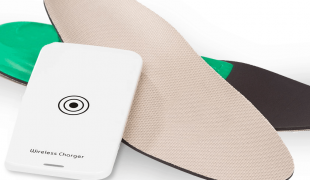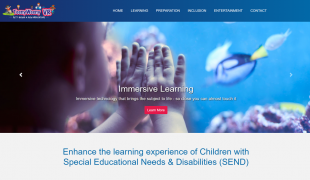- 2966
- 266
- 5
- 6
- 0
- Help Ukraine
About the solution
Inspired by his nonverbal autistic son Jaxon, Justin Behnke, a dedicated father from Phoenix, has created a product called 'Scan Me Home'. Jaxon, who is on the autism spectrum and non-verbal, has taught his father invaluable lessons about life and communication. Despite this strong bond, Justin faces significant challenges, particularly Jaxon's tendency to run or wander off. This behavior, known as elopement, is common among children on the autism spectrum and poses a constant risk to their safety.
A terrifying incident at the Great Wolf Lodge, where Jaxon went missing for a brief yet panic-inducing moment, spurred Justin to develop a practical solution to ensure the safety of his son and others like him. This experience highlighted the need for a reliable method to quickly reconnect with a child who has wandered away.
The "Scan Me Home" is a pioneering solution designed to address the critical issue of wandering in children with autism and other conditions that make verbal communication difficult, this solution is a QR code that can be easily ironed onto any piece of clothing. If a child wanders off, a simple scan of this QR code by a passerby or authority figure immediately reveals the child's profile and essential information. Once the QR code is scanned, the system prompts the scanner to call the child's emergency contact. This ensures that parents or guardians are notified as soon as the child is found, significantly reducing the time and stress involved in locating a missing child. For parents like Justin Behnke, who live with the constant fear of their child wandering away, Scan Me Home provides invaluable peace of mind. Knowing that their child's essential information is readily accessible to anyone who finds them offers a sense of security and reassurance.
By raising awareness about Scan Me Home, Justin hopes to educate the community on how to respond when they encounter someone with the QR code. This collective knowledge can create a supportive environment where the chances of quickly and safely reuniting a child with their family are greatly increased. The system is straightforward and user-friendly. Parents can create a profile and register their child's information quickly. The QR code can be easily applied to the child's clothing, making it a practical tool for everyday use.
Source of information: https://www.azfamily.com/video/2023/12/12/phoenix-dad-creates-app-help-f...
Contact information: https://scanmehome.com | https://www.facebook.com/justin.behnke.52/ | linkedin.com/in/justin-behnke-a9b8a2102
https://youtu.be/LS3uLXL4IOo?si=72X1iH6Z9-xgpz7P
This solution shall not include mention to the use of drugs, chemicals or biologicals (including food); invasive devices; offensive, commercial or inherently dangerous content. This solution was not medically validated. Proceed with caution! If you have any doubts, please consult with a health professional.
DISCLAIMER: This story was written by someone who is not the author of the solution, therefore please be advised that, although it was written with the utmost respect for the innovation and the innovator, there can be some incorrect statements. If you find any errors please contact the patient Innovation team via info@patient-innovation.com
-
-
411
-
2
-
9256

SmartSole GPS - Tracker for people with Alzheimer's, dementia and autism
COMMUNICATION: Communicating, whether by speaking, listening, or other means
WALKING: Walking
CAREGIVING
Alzheimer's Disease
Dementia (Alcoholic Dementia, Vascular Dementia)
Body-Worn solutions (Clothing, accessories, shoes, sensors...)
Difficulty coordinating movements
Loss of balance
Social withdrawal or isolation
Cognitive impairment
Memory loss
Irritability or anger outbursts
Confusion
Restlessness or feeling slowed down
Anxiety
Panic attacks
Difficulty controlling impulses
Mood swings
Feelings of guilt or worthlessness
Suicidal thoughts or behaviors
Hallucinations (perceiving things that aren't there)
Dizziness or lightheadedness
Fatigue
Restoring mobility
Promoting self-management
Building Supportive Community Relationships
Promoting inclusivity and social integration
Improving Speech and Communication
Preventing (Vaccination, Protection, Falls, Research/Mapping)
Raise awareness
Caregiving Support
Child and Adolescent Psychiatry
General and Family Medicine
Internal Medicine
Medical Genetics
Neurology
Pediatrics
Psychiatry
United States
-
-
-
387
-
0
-
4486

Teeny Weeny VR- a new way of terapy for autistic children.
CAREGIVING
COMMUNICATION: Communicating, whether by speaking, listening, or other means
Autism
AI algorithm
Anxiety
Difficulty concentrating or making decisions
Social withdrawal or isolation
Promoting self-management
Managing Neurological Disorders
Building Supportive Community Relationships
Promoting inclusivity and social integration
Improving Speech and Communication
To improve Treatment/Therapy
Preventing (Vaccination, Protection, Falls, Research/Mapping)
Raise awareness
Caregiving Support
Child and Adolescent Psychiatry
General and Family Medicine
Neurology
Pediatrics
Psychiatry
United Kingdom
-
-
-
402
-
0
-
5437

Mother creates weighted cape to help her special needs daugther
CAREGIVING
Urban exploration
COMMUNICATION: Communicating, whether by speaking, listening, or other means
Post traumatic stress disorder (PTSD)
Anxiety
Body-Worn solutions (Clothing, accessories, shoes, sensors...)
Anxiety
Social withdrawal or isolation
Irritability or anger outbursts
Restlessness or feeling slowed down
Panic attacks
Racing thoughts
Feelings of guilt or worthlessness
Suicidal thoughts or behaviors
Obsessive thoughts or compulsive behaviors
Hallucinations (perceiving things that aren't there)
Sleep disturbances
Managing pain
Promoting self-management
Managing Neurological Disorders
Promoting inclusivity and social integration
Enhancing Mental Health
Improving Speech and Communication
To improve Treatment/Therapy
Preventing (Vaccination, Protection, Falls, Research/Mapping)
Raise awareness
Child and Adolescent Psychiatry
Neurology
Pediatrics
Physical Medicine and Rehabilitation
United States
-
 en
en